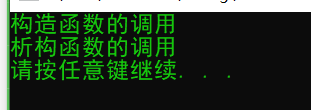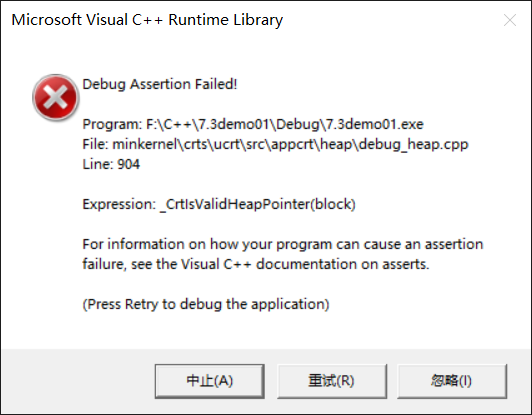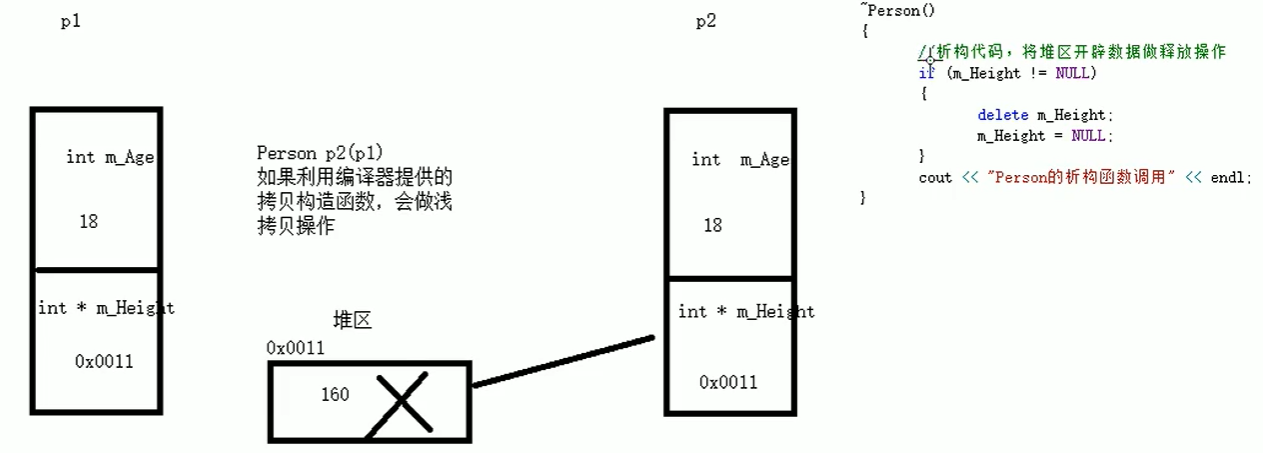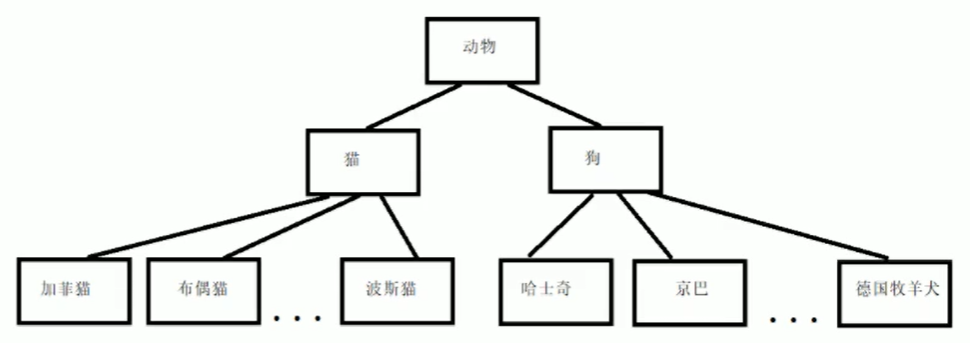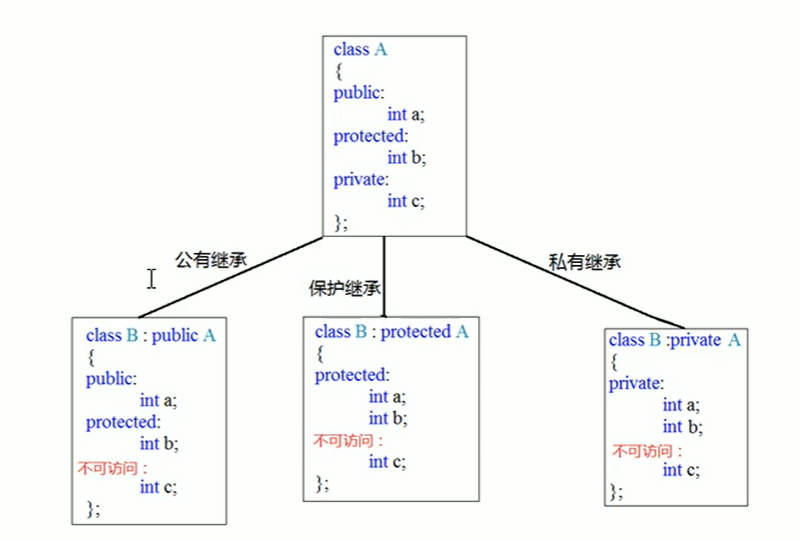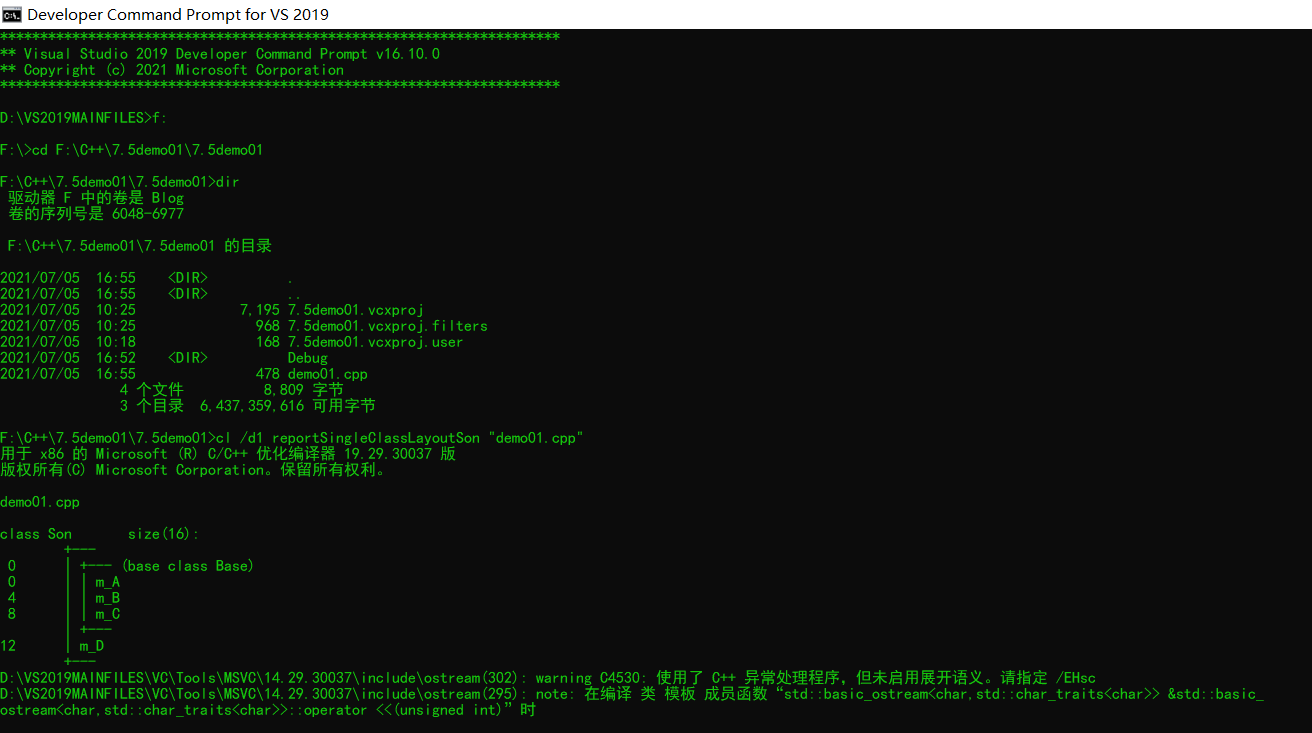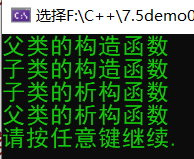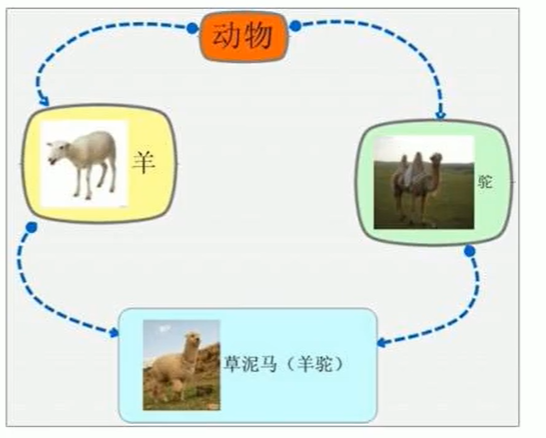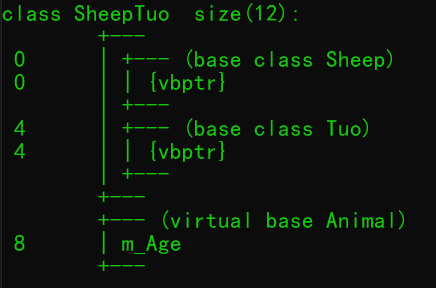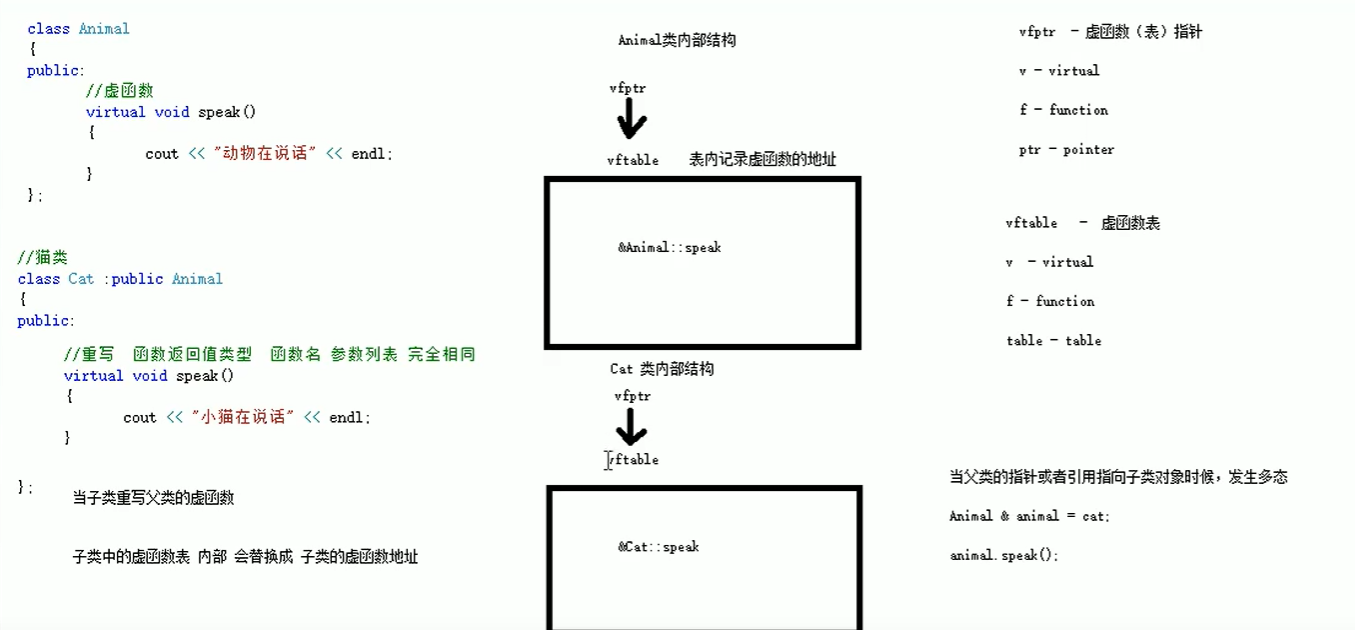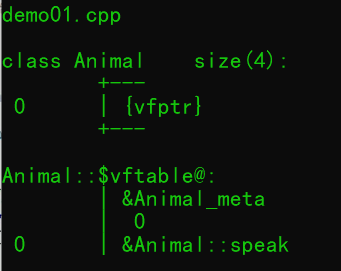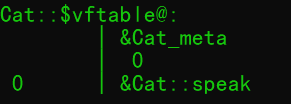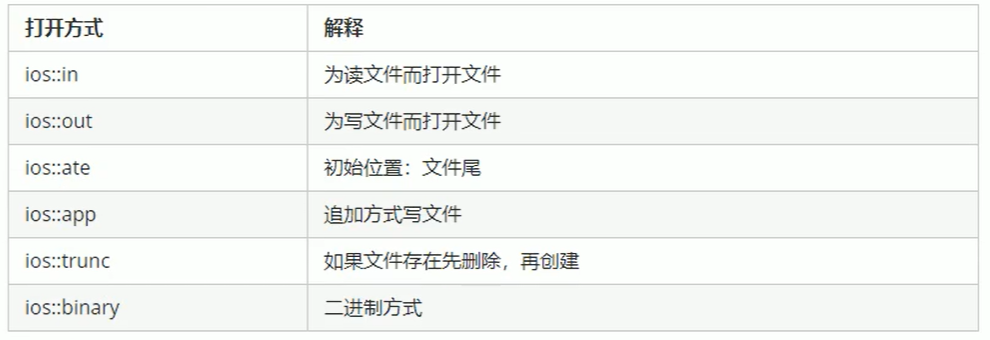相关视频——黑马程序员匠心之作|C++教程从0到1入门编程,学习编程不再难_哔哩哔哩_bilibili (84-146)
基础部分(1-83)—— 如果你准备学习C++,并且有C语言的基础,我希望你能简单的过一遍知识点。 https://blog.csdn.net/qq_51604330/article/details/117753463?spm=1001.2014.3001.5501 )
C++核心编程部分 内存分区模型
代码区:存放函数的二级制代码,由操作系统进行管理的
全局区:存放全局变量和静态变量以及常量
栈区:由编译器自动分配释放,存放函数的参数值,局部变量等
堆区: 由程序员分配和释放,若程序员不释放,程序结束时由操作系统回收
内存四区意义 :不同区域存放的数据,赋予不同的声明周期,给我们更大的灵活编程
程序运行前 在程序编译后,生成了exe可执行文件,未执行该程序前分为两个区域。
代码区:
存放cpu执行的机器指令
代码区是共享的,共享的目的是对于频繁被执行的程序,只需要在内存中有一份打码即可
代码区是只读的,使其只读的原因是防止程序意外的修改了它的指令
全局区:
全局变量和静态变量存放于此
全局区还包含了常量区,字符串常量和其他常量也存放于此
该区域的数据在程序结束之后由操作系统释放
程序运行后 栈区:
由编译器自动分配释放,存放函数的参数值,局部变量等。
注意事项:不要返回局部变量的地址,栈区开辟的数据由编译器自动释放
堆区:
有程序员分配释放,若程序员不释放,程序结束之后有操作系统回收
在C++中主要利用new在堆区中开辟内存
new运算符 在堆区开辟数据
堆区开辟的数据,由程序员手动开辟,手动释放,释放用delete
语法 :
利用new创建的数据,会返回该数据对应类型的指针
1 2 int * p = new int (10 );int * arry = new int [10 ];
1 2 delete p; delete [] arry;
引用 基本使用 作用 :给变量起别名
语法 :数据类型 &别名 = 原名
注意事项
引用必须初始化——告诉它它是谁的别名
引用在初始化之后,不可以改变
做函数参数 作用 :函数传参时,可以利用引用让形参修饰实参
优点 :可以简化指针修改实参(传址)。
1 2 3 4 5 6 7 8 9 void changeNums (int &a,int & b) int main (void ) int a = 10 ; int b = 20 ; changeNums(int &a,int & b) return 0 ; }
做函数的返回值 注意 :不要返回局部变量引用
用法:函数调用作为左值
1 2 3 4 5 6 7 8 9 10 11 12 13 14 15 16 17 18 19 20 21 22 23 24 #include <iostream> using namespace std ;int & test1 () int a = 10 ; return a; } int & test2 () static int b = 20 ; return b; } int main (void ) int & ret = test1(); int & ret2 = test2(); cout << ret2 << endl ; test2() = 1000 ; cout << ret2 << endl ; cout << ret << endl ; cout << ret; return 0 ; }
引用本质 本质 :引用的本质在c++内部实现是一个指针常量,引用一旦被初始化之后就不能更改。
1 2 3 4 5 6 7 8 9 10 void func (int & ref) ref = 100 ; } int main (void ) int a = 10 ; int &ref = a; ref =20 ; }
结论 :C++推荐使用引用技术,因为语法方便,引用本质是指针常量,但所有的指针操作编译器都棒我们做了。
常量引用 作用 :常量引用主要用来修饰形参,防止误操作
1 2 3 4 5 6 7 const int & ref = 10 ;
在函数形参列表中,可以加const修饰形参,防止形参改变实参
1 2 3 4 void showvaL (const int & ref) }
函数提高 函数默认参数 在c++中函数形参列表中的形参是可以有默认值的。
语法:返回值类型 函数名(参数=默认值)
1 2 3 4 5 6 7 8 9 10 int func (int a,int b =10 ,int c =23 ) return a+b+c; } int main (void ) int ref = func(10 ); return 0 ; }
注意事项:如果某个位置已经有了默认参数,那么从这个位置往后都要有默认参数
1 2 3 4 5 int fun2 (int a,int b= 10 ;int c =20 ) }
如果函数的声明有默认参数,函数的实现就不能有默认参数了。
声明和实现只能有一个有默认参数。
1 2 3 4 5 int fun3 (int a = 10 ;int b = 20 ) int fun3 (int a,int b) }
函数占位参数 C++中函数的形参列表里可以有占位参数,用来占位,调用函数的时候必须填补该位置。
语法:返回值类型 函数名 (数据类型){},
在现阶段函数的占位参数存在意义不大,但是后面的课程中会用到该技术。
1 2 3 4 5 6 7 8 9 void func (int a, int ) } int main (void ) func(10 ,1 ); return 0 ; }
占位参数还可以有默认参数
1 2 3 4 5 6 7 8 9 void func (int a, int =10 ) } int main (void ) func(10 ); return 0 ; }
函数重载 作用 :函数名可以相同,提高复用性
函数重载满足条件
同一个作用域下
函数名相同
函数参数类型不同或者个数不同或者顺序不同
注意 :函数的返回值不可以作为函数重载的条件
1 2 3 4 5 6 7 8 9 10 11 12 13 14 15 void func () cout << "无参数" << endl ; } void func (int a) cout << a; } int main (void ) 根据函数传递参数的不同调用不同的代码 func(); func(10 ); return 0 ; }
函数重载的注意事项
1 2 3 4 5 6 7 8 9 10 11 12 13 14 15 16 17 #include <iostream> using namespace std ;void func (int &a) } void func (const int &a) } int main (void ) func(10 ); return 0 ; }
1 2 3 4 5 6 7 8 9 10 11 12 13 14 15 16 17 18 19 20 21 #include <iostream> using namespace std ;void func (int a ,int b = 10 ) } void func (int a) } int main (void ) func(10 ); return 0 ; }
类和对象 C++面向对象的三大特性为:封装、继承、多态。
C++认为万事万物皆为对象,对象上有其属性和行为
例如 :
人可以作为对象,属性有姓名、年龄、身高、体重……行为有唱、跳、跑……
车也可以作为对象,属性有轮胎、方向盘、大灯……行为有载人、放音乐、开空调……
具有相同性质的对象,我们可以抽象称为类,人属于人类,车属于车类……
封装 封装的意义 封装是C++面向对象的三大特征之一
封装的意义:
将属性和行为作为一个整体,表现生活中的事物
将属性和行为加以权限控制
封装的意义一 在设计类的时候,属性和行为写在一起,表现事物
语法 :
1 class 类名{
例子 示例1
创建一个圆类,求圆的周长
1 2 3 4 5 6 7 8 9 10 11 12 13 14 15 16 17 18 19 20 21 22 23 24 25 26 27 28 29 30 #include <iostream> using namespace std ;double pi = 3.14 ;class Circle { public : int c_r; double calculateZC () { return 2 * pi * c_r; } }; int main (void ) Circle c1; c1.c_r = 10 ; cout << "圆的周长为" << c1.calculateZC() << endl ; return 0 ; }
示例2
创建一个学生类
1 2 3 4 5 6 7 8 9 10 11 12 13 14 15 16 17 18 19 20 21 22 23 24 25 26 27 28 29 #include <iostream> #include <string> using namespace std ;class Student { public : string s_Name; int s_Id; void showStudent () { cout << "姓名: " << s_Name << "ID:" << s_Id << endl ; } void inputName (string name) { s_Name = name; } }; int main (void ) Student s1; s1.inputName("赵六" ); s1.s_Id = 123456 ; s1.showStudent(); return 0 ; }
类中的属性和行为,我们统称为成员
属性-成员属性-成员变量
行为-成员函数-成员方法
封装的意义二 类在设计时,可以把属性和行为放在不同的权限下,加以控制
访问权限有三种
public——公共权限——成员类内可以访问,类外可以访问
protected–保护权限——成员类内可以访问,类外不可以访问
private——私有权限——成员类内可以访问,类外不可以访问
1 2 3 4 5 6 7 8 9 10 11 12 13 14 15 16 17 18 19 20 21 22 23 24 25 26 27 28 #include <iostream> #include <string> using namespace std ;class Person { public : string p_name; protected : string p_car; private : int p_password; public : void funcshow () { p_name = "张三" ; p_car = "拖拉机" ; p_password = 123456 ; } }; int main (void ) Person p1; p1.p_name = "王五" ; return 0 ; }
struct和class 在C++中struct和class的唯一区别就是默认的访问权限不同。
区别 :
struct默认权限为公共public
class默认权限为私有private
成员属性设置为私有
优点1 :将所有成员属性设置为私有,可以自己控制读写权限。
优点2 :对于写权限,我们可以检测数据的有效性。
示例 :
1 2 3 4 5 6 7 8 9 10 11 12 13 14 15 16 17 18 19 20 21 22 23 24 25 26 27 28 29 30 31 32 33 34 35 36 37 38 39 40 41 42 43 44 45 46 47 48 49 50 51 52 53 54 55 56 57 58 #include <iostream> #include <string> using namespace std ;class Person { public : void setName (string name) { p_name = name; } string getName () { return p_name; } int getAge () { return p_age; } void setAge (int age) { p_age = age; if (age < 0 || age >150 ) { p_age = 0 ; cout << "什么鬼" << endl ; return ; } } void setLover (string lname) { lover = lname; } private : string p_name; int p_age; string lover; }; int main (void ) Person p1; p1.setName("张三" ); cout << "姓名:" << p1.getName() << endl ; p1.setAge(18 ); cout << "年龄:" << p1.getAge() << endl ; p1.setLover("赵四" ); return 0 ; }
练习案例 (1)设计立方体类 求立方体的面积和体积
分别用全局函数和成员函数判断两个立方体是否相等
1 2 3 4 5 6 7 8 9 10 11 12 13 14 15 16 17 18 19 20 21 22 23 24 25 26 27 28 29 30 31 32 33 34 35 36 37 38 39 40 41 42 43 44 45 46 47 48 49 50 51 52 53 54 55 56 57 58 59 60 61 62 63 64 65 66 67 68 69 70 71 72 73 74 75 76 77 78 79 80 81 82 83 84 85 86 87 88 89 90 91 92 93 94 95 96 97 98 99 100 101 102 #include <iostream> using namespace std ;class Cube { public : void setl (int l) { C_L = l; } int getl () { return C_L; } void setw (int w) { C_W = w; } int getw () { return C_W; } void seth (int h) { C_H= h; } int geth () { return C_H; } int calculateS () { return 2 * C_L * C_W + 2 * C_L * C_H + 2 * C_W * C_H; } int calculateV () { return C_L * C_W * C_H; } bool issamebyClass (Cube &c) { if (C_H== c.geth() && C_L == c.getl() && C_W == c.getw()) { return true ; } return false ; } private : int C_L; int C_W; int C_H; }; bool issame (Cube &c1, Cube &c2) if (c1.geth() == c2.geth() && c1.getl() == c2.getl() && c1.getw() == c2.getw()) { return true ; } return false ; } int main (void ) Cube c1; c1.seth(10 ); c1.setl(10 ); c1.setw(10 ); cout << c1.calculateS() << endl ; cout << c1.calculateV() << endl ; Cube c2; c2.seth(10 ); c2.setl(10 ); c2.setw(10 ); bool ret = issame(c1, c2); if (ret) { cout << "c1和c2相等" << endl ; } else { cout << "c1和c2不相等" << endl ; } bool ret2 = c1.issamebyClass(c2); if (ret2) { cout << "利用成员函数,c1和c2相等" << endl ; } else { cout << "利用成员函数,c1和c2不相等" << endl ; } system("pause" ); return 0 ; }
(2)点和圆的关系 设计一个圆类和一个点类判断圆和点的关系。
在一个类中可以让另一个类作为这个类的成员
1 2 3 4 5 6 7 8 9 10 11 12 13 14 15 16 17 18 19 20 21 22 23 24 25 26 27 28 29 30 31 32 33 34 35 36 37 38 39 40 41 42 43 44 45 46 47 48 49 50 51 52 53 54 55 56 57 58 59 60 61 62 63 64 65 66 67 68 69 70 71 72 73 74 75 76 77 78 79 80 81 82 83 84 #include <iostream> using namespace std ;class Point { public : void setx (int x) { c_x = x; } int getx () { return c_x; } void sety (int y) { c_y = y; } int gety () { return c_y; } private : int c_x; int c_y; }; class Circle { public : void setr (int r) { c_R = r; } int getr () { return c_R; } void setcenter (Point center) { c_center = center; } Point getcenter () { return c_center; } private : int c_R; Point c_center; }; void isInCircle (Circle &c,Point &p) int distance = (c.getcenter().getx() - p.getx()) * (c.getcenter().getx() - p.getx()) + (c.getcenter().gety() - p.gety()) * (c.getcenter().gety() - p.gety()); int rdistance = c.getr() * c.getr(); if (distance == rdistance) { cout << "点在圆上" << endl ; } else if (distance > rdistance) { cout << "点在圆外" << endl ; } else { cout << "点在圆内" << endl ; } } int main (void ) Circle c1; c1.setr(10 ); Point center; center.setx(10 ); center.sety(10 ); c1.setcenter(center); Point p1; p1.setx(3 ); p1.sety(4 ); isInCircle(c1, p1); return 0 ; }
将一个类拆分成两个文件
point.h
1 2 3 4 5 6 7 8 9 10 11 12 13 14 #pragma once #include <iostream> using namespace std ;class Point { public : void setx (int x) int getx () void sety (int y) int gety () private : int c_x; int c_y; };
point.cpp
1 2 3 4 5 6 7 8 9 10 11 12 13 14 15 16 17 18 #include "point.h" void Point::setx (int x) c_x = x; } int Point::getx () return c_x; } void Point::sety (int y) Point::c_y = y; } int Point::gety () return c_y; }
对象的初始化清理
在生活中我们所购买的点子产品大多都有恢复出厂设置,在某一天我们不使用的时候清楚自己的数据来保证自己信息的安全。
C++中的面向对象来源生活,每个对象也会有初识设置以及对象销毁前的清理数据的设置。、
构造函数和析构函数 对象的初始化和清理 也是两个非常重要的安全问题。
一个对象或者变量没有初识状态,对其使用后的后果是未知的。
同样的使用完一个对象或者变量,没有及时进行清理,也会造成一定的安全问题。
C++利用了构造函数和析构函数 解决上述问题,这两个函数将会被编译器自动斓用,完成对象初始化和清理工作。对象的初始化和清理工作是编译器强制要我们做的事情,因此如果我们不提供构造和析构,编译器会提供,但是编译器提供的构造函数和析构函数是空实现 。
构造函数:主要作用在于创建对象时为对象的成员属性赋值,构造函数由编译器自动调用,无须手动调用。
析构函数:主要作用在于对象销毁前系统自动调用,执行一些清理工作。
构造函数语法
构造函数没有返回值也不写void
函数名称与类名相同
构造函数可以有参数,因此可以发生重载
程序在调用对象的时候会自动调用构造,无须手动调用,而且只会调用一次
1 2 3 4 5 6 7 8 9 10 11 12 13 14 15 16 17 18 19 20 21 #include <iostream> using namespace std ;class Person { public : Person() { cout << "构造函数的调用" << endl ; } }; void test01 () Person p; } int main (void ) test01(); system("pause" ); return 0 ; }
析构函数语法
析构函数没有返回值也不写void
函数名称与类名相同,在名称前加上~
析构函数不可以有参数,因此不可以发生重载
程序在对象销毁前会自动调用析构,无须手动调用,而且只会调用一次
1 2 3 4 5 6 7 8 9 10 11 12 13 14 15 16 17 18 19 20 21 22 23 24 25 26 #include <iostream> using namespace std ;class Person { public : Person() { cout << "构造函数的调用" << endl ; } ~Person() { cout << "析构函数的调用" << endl ; } }; void test01 () Person p; } int main (void ) test01(); system("pause" ); return 0 ; }
构造函数的分类及调用 两种分类方式:
按参数分为:有参构造和无参构造
按类型分为:普通构造和拷贝构造
三种调用方式:
1 2 3 4 5 6 7 Person p; Person p2 (10 ) ; Person p3 (p2) ; cout << "p2的年龄为" << p2.age << endl ; cout << "p3的年龄为" << p3.age << endl ;
1 2 3 4 5 6 7 Person p1; Person p2 = Person(10 ); Person p3 = Person(p2);
隐式转换法
1 2 Person p4 = 10 ; Person p5 = p4;
全部代码 :
1 2 3 4 5 6 7 8 9 10 11 12 13 14 15 16 17 18 19 20 21 22 23 24 25 26 27 28 29 30 31 32 33 34 35 36 37 38 39 40 41 42 43 44 45 46 47 48 49 50 51 52 53 54 55 56 57 58 59 60 61 62 63 64 65 66 67 68 69 70 71 72 73 74 75 76 77 78 79 80 81 82 83 84 85 86 87 88 89 90 91 92 93 94 95 96 97 98 99 100 101 102 103 104 105 106 107 108 109 110 111 112 113 114 115 116 117 118 119 120 121 122 123 124 125 126 127 128 129 130 131 #include <iostream> using namespace std ; class Person { public : Person() { cout << "Person的无参构造函数调用" << endl ; } Person(int a) { age = a; cout << "Person的有参构造函数调用" << endl ; } ~Person() { cout << "Person的析构函数调用" << endl ; } Person(const Person &p) { age = p.age; cout << "拷贝构造函数调用" << endl ; } int age; }; int main (void ) { Person p4 = 10 ; Person p5 = p4; system("pause" ); return 0 ; } #### 拷贝构造函数调用时机 C++中拷贝构造函数调用时机通常有三种情况 - 使用一个已经创建完毕的对象来初始化一个新对象 - 值传递的方式给函数参数传值 - 以值方式返回局部对象 ```c++ #include <iostream> using namespace std ;class Person { public : Person() { cout << "Person的默认构造函数调用" << endl ; } Person(int age) { cout << "Person的有参构造函数调用" << endl ; m_Age = age; } Person(const Person& p) { cout << "Person的拷贝构造函数调用" << endl ; m_Age = p.m_Age; } ~Person() { cout << "Person的析构函数调用" << endl ; } int m_Age; }; void test01 () Person p1 (20 ) ; Person p2 (p1) ; cout << "p2的年龄为" << p2.m_Age << endl ; } void dowork (Person p) } void test02 () Person p; dowork(p); } Person dowork2 () Person p1; cout << (int *)&p1 << endl ; return p1; } void test03 () Person p = dowork2(); cout << (int *)&p << endl ; } int main (void ) test03(); system("pause" ); return 0 ; }
构造函数的调用规则 默认情况下,C++编译器至少给一个类添加三个函数
默认构造函数(无参、函数体为空)
默认析构函数(无参、函数体为空)
默认拷贝函数构造函数,对属性值拷贝
构造函数调用规则如下:
如果用户定义有参构造函数,C++不再提供默认无参构造,但是会提供默认拷贝构造
如果用户定义拷贝构造函数,C++不会再提供其他构造函数
1 2 3 4 5 6 7 8 9 10 11 12 13 14 15 16 17 18 19 20 21 22 23 24 25 26 27 28 29 30 31 32 33 34 35 36 37 38 39 40 41 42 43 44 45 46 47 48 49 50 #include <iostream> using namespace std ;class Person { public : Person() { cout << "Person的默认构造函数调用" << endl ; } Person(int age) { m_Age = age; cout << "Person的有参构造函数调用" << endl ; } Person(const Person& p) { m_Age = p.m_Age; cout << "Person的拷贝构造函数调用" << endl ; } ~Person() { cout << "Person的默认析构函数调用" << endl ; } int m_Age; }; void test () Person p; p.m_Age = 18 ; Person p2 (p) ; cout << "p2的年龄为" << p2.m_Age << endl ; } void test02 () } int main (void ) test02(); system("pause" ); return 0 ; }
总结 :
用户提供了有参,编译器不会提供无参,但会提供拷贝;
用户提供了拷贝,编译器什么构造函数都不会提供。
深拷贝与浅拷贝 深浅拷贝是面试的一个经典的问题,也是常见的一个坑。
浅拷贝 :简单的赋值拷贝操作。
深拷贝 :在堆区中重新申请空间,进行拷贝操作。
浅拷贝带来的问题——内存重复释放 。
1 2 3 4 5 6 7 8 9 10 11 12 13 14 15 16 17 18 19 20 21 22 23 24 25 26 27 28 29 30 31 32 33 34 35 36 37 38 39 40 41 42 43 44 45 46 47 48 49 50 51 #include <iostream> using namespace std ;class Person { public : Person() { cout << "Person的默认构造函数调用" << endl ; } Person(int age,int height) { m_Height = new int (height); m_Age = age; cout << "Person的有参构造函数调用" << endl ; } Person(const Person& p) { cout << "Person的拷贝构造函数调用" << endl ; m_Age = p.m_Age; m_Height = p.m_Height;编译器默认实现的就是这行代码 } ~Person() { if (m_Height !=NULL ) { delete m_Height; m_Height = NULL ; } cout << "Person的析构构造函数调用" << endl ; } int m_Age; int * m_Height; }; void test () Person p1 (18 ,166 ) ; cout << p1.m_Age<<"\t" << *p1.m_Height << endl ; Person p2 (p1) ; cout << p2.m_Age<<"\t" <<*p2.m_Height<< endl ; } int main (void ) test(); system("pause" ); return 0 ; }
浅拷贝的这个问题需要用深拷贝来解决
重新在堆区找一块内存来存放他。
自己实现拷贝构造函数来解决浅拷贝带来的问题
解决 :
深拷贝 ——手动创建拷贝构造函数。
1 2 3 4 5 6 7 8 Person(const Person& p) { cout << "Person的拷贝构造函数调用" << endl ; m_Age = p.m_Age; m_Height = new int (*p.m_Height); }
总结 :
如果有属性在堆区开辟的,一定要自己提供拷贝构造函数,防止浅拷贝带来的问题。
初识化列表 作用 :
C++提供了初始化列表语法,用来初始化对象。
语法 :
构造函数():属性1(值1),属性2(值2)…{}
示例 :
1 2 3 4 5 6 7 8 9 10 11 12 13 14 15 16 17 18 19 20 21 22 23 24 25 26 27 28 29 30 31 32 33 34 35 36 #include <iostream> using namespace std ;class Person { public : Person(int a,int b,int c) :m_A(a), m_B(b), m_C(c) { } int m_A; int m_B; int m_C; }; void test () Person p (30 ,20 ,10 ) ; cout << p.m_A << endl ; cout << p.m_B << endl ; cout << p.m_C << endl ; } int main (void ) test(); system("pause" ); return 0 ; }
类对象作为类成员 C++中类的成员可以是另一个类的对象,我们称该成员为对象成员。
例如 :
1 2 3 4 5 class A {class B { A a; }
B类中有对象A作为成员,A为对象成员。
那么当创建B对时,A与B的构造和析构的顺序是怎么样的?
A先被构造
当其他类的对象作为本类的成员时,构造时先构造其他类的对象,再构造自身。
析构呢?与构造函数相反。
自身的析构函数先进行,之后其它类再进行。
1 2 3 4 5 6 7 8 9 10 11 12 13 14 15 16 17 18 19 20 21 22 23 24 25 26 27 28 29 30 31 32 33 34 35 36 37 38 39 40 41 42 43 44 45 46 #include <iostream> #include <string> using namespace std ;class Phone { public : Phone(string p) { Phonename = p; cout << "Phone的构造函数调用" << endl ; } ~Phone() { cout << "Phone的析构函数调用" << endl ; } string Phonename; }; class Person { public : Person(string name, string pname):Personname(name), Personphone(pname) { cout << "Person的构造函数调用" << endl ; } ~Person() { cout << "Person的析构函数调用" << endl ; } string Personname; Phone Personphone; }; void test () Person p ("张三" , "华为" ) ; cout << p.Personname<< endl ; cout << p.Personphone.Phonename<< endl ; } int main (void ) test(); system("pause" ); return 0 ; }
静态成员 静态成员就是在成员变量和成员函数前面加上关键字啊static,称为静态成员。
静态成员分为 :
静态成员变量
所有对象共享同一份数据
在编译阶段分配内存
类内声明,类外初始化
静态成员函数
所有成员共享同一个函数
静态成员函数只能访问静态成员变量
1 2 3 4 5 6 7 8 9 10 11 12 13 14 15 16 17 18 19 20 21 22 23 24 25 26 27 28 29 30 31 32 33 34 35 36 #include <iostream> using namespace std ;class Person { public : static void func () { age = 100 ; cout << "static void func调用" << endl ; } static int age; private : static void func () { } }; void test01 () Person p; p.func(); Person::func(); } int main (void ) test01(); system("pause" ); return 0 ; }
C++对象模型和this指针 成员变量和成员函数分开存储 在C++中,类内的成员变量和成员函数分开存储,
只有非静态成员变量才属于类的对象上。
(只有非静态成员变量的大小算进类的大小中,其他的都不算。)
空对象的大小是1,为的是区分不同类在内存中的占用位置。
1 2 3 4 5 6 7 8 9 10 11 12 13 14 15 16 17 18 19 20 21 22 23 24 25 26 27 28 29 30 31 #include <iostream> using namespace std ;class Person { int m_A; static int m_B; void func () static void func2()}//静态成员函数不属于类的对象上 }; int Person::m_B = 10 ;void test01 () Person p; cout << sizeof (p) << endl ; } void test02 () Person p; cout << sizeof (p) << endl ; } int main (void ) test01(); test02(); system("pause" ); return 0 ; }
this指针的概念 通过上一个知识点《成员变量和成员函数是分开存储的》我们知道C++中成员变量和成员函数是分开存储的。
每一个非静态成员函数只会诞生一份函数实例,也就是说多个同类型的对象会公用一块代码。
那么问题是:这一块代码是如何区分是哪个对象调用自己的呢?
C++通过提供特殊的对象指针,this指针,解决上述问题。
this指针指向被调用的成员函数所属的对象 。
(谁调的,this就指向谁)
this指针是隐含每个非静态成员函数内的一种指针。
this指针不需要定义,直接使用即可。
this指针的用途
当形参和成员变量同名时,可用this指针来区分
在类的非静态成员函数中返回对象本身,可使用return *this
解决名称冲突
返回对象本身用*this
1 2 3 4 5 6 7 8 9 10 11 12 13 14 15 16 17 18 19 20 21 22 23 24 25 26 27 28 29 30 31 32 33 34 35 36 37 38 39 40 41 42 43 #include <iostream> using namespace std ;class Person { public : Person(int age) { this ->age = age; } Person& PersonAddPerson (Person &p) { this ->age += p.age; return *this ; } int age; }; void test () Person p (18 ) ; cout << p.age << endl ; } void test01 () Person p1 (10 ) ; Person p2 (10 ) ; p2.PersonAddPerson(p1); p2.PersonAddPerson(p1).PersonAddPerson(p1); cout << p2.age << endl ; } int main (void ) test01(); system("pause" ); return 0 ; }
空指针返回成员函数 C++中空指针也是可以调用成员函数的,但是也要注意有没有用到this指针,如果用到this指针,需要加以判断来保证代码的健壮性。
1 2 3 4 5 6 7 8 9 10 11 12 13 14 15 16 17 18 19 20 21 22 23 24 25 26 27 28 29 30 31 32 33 34 #include <iostream> using namespace std ;class Person { public : void ShowClassName () { cout << "this is Person class" << endl ; } void ShowPersonAge () { if (this == NULL ) { return ; } cout << this ->m_Age << endl ; } int m_Age; }; void test () Person* p = NULL ; p->ShowClassName(); p->ShowPersonAge(); } int main (void ) test(); system("pause" ); return 0 ; }
const修饰成员函数 常函数 :
成员函数后加const后我们称这个函数为常函数
常函数不可以修改成员属性
成员属性声明时加关键字mutable后,在常函数中依然可以修改
常对象 :
声明对象前const称该对象为常对象。
常对象只能调用常函数。
1 2 3 4 5 6 7 8 9 10 11 12 13 14 15 16 17 18 19 20 21 22 23 24 25 26 27 28 29 30 31 32 33 34 35 36 37 38 39 40 41 42 43 44 #include <iostream> using namespace std ;class Person { public : void showPerson () const { this ->m_b = 100 ; } int m_a; mutable int m_b; void func () { m_a = 100 ; } }; void test () Person P; P.showPerson(); } void test1 () const Person p; p.m_b = 100 ; p.showPerson(); } int main (void ) test(); system("pause" ); return 0 ; }
友元 可客厅就是Public,你的卧室就是Private
客厅所有人都可以进去,但是你的卧室只有和你亲密的人可以进。
在程序中,有些私有属性也想让类外特殊的一些函数或者类进行访问,就需要用到友元技术。
友元的目的就是让一个函数或者类 访问另一个类中的私有元素。
友元的关键字——friend
友元的三种实现
全局函数做友元 就是将此函数在类的最上面写一个声明,前面加一个friend。
1 2 3 4 5 6 7 8 9 10 11 12 13 14 15 16 17 18 19 20 21 22 23 24 25 26 27 28 29 30 31 32 33 34 35 36 37 #include <iostream> #include <string> using namespace std ;class Building { friend void goodgay (Building* building) public : Building() { m_SittingRoom = "客厅" ; m_BedRoom = "卧室" ; } public : string m_SittingRoom; private : string m_BedRoom; }; void goodgay (Building* building) cout << "好基友全局函数正在访问你的" << building->m_SittingRoom << endl ; cout << "好基友全局函数正在访问你的" << building->m_BedRoom << endl ; } void test () Building building; goodgay(&building); } int main (void ) test(); system("pause" ); return 0 ; }
类做友元 一个类在另一个中friend class xx。
1 2 3 4 5 6 7 8 9 10 11 12 13 14 15 16 17 18 19 20 21 22 23 24 25 26 27 28 29 30 31 32 33 34 35 36 37 38 39 40 41 42 43 44 45 46 47 48 49 50 51 52 53 54 55 #include<iostream> #include<string> using namespace std; //在前面先声明一下 class Building; class GoodGay { public: GoodGay(); public: void visit();//参观函数 访问Building中的属性 Building* building; }; class Building { //GoodGay是Building类的好朋友,可以访问其私有属性 friend class GoodGay; public: Building(); public: string m_SittingRoom; private: string m_BedRoom; }; //在类外写成员函数 Building::Building() { m_SittingRoom = "客厅"; m_BedRoom = "卧室"; } GoodGay::GoodGay() { //创建一个Building对象 building = new Building; } void GoodGay::visit() { cout << "好基友正在访问你的" << building->m_SittingRoom << endl; cout << "好基友正在访问你的" << building->m_BedRoom << endl; } void test() { GoodGay gy; gy.visit(); } int main(void) { test(); system("pause"); return 0; }
成员函数做友元 告诉编译器 另一个类中的xx成员函数作为本类的好朋友,可以访问私有函数。
1 2 3 4 5 6 7 8 9 10 11 12 13 14 15 16 17 18 19 20 21 22 23 24 25 26 27 28 29 30 31 32 33 34 35 36 37 38 39 40 41 42 43 44 45 46 47 48 49 50 51 52 53 54 55 56 57 58 #include <iostream> #include <string> using namespace std ;class Building ;class GoodGay { public : GoodGay(); void visit () void visit1 () Building* builidng; }; class Building { friend void GoodGay::visit () public : Building(); public : string m_SittingRoom; private : string m_BedRoom; }; Building::Building() { m_SittingRoom = "客厅" ; m_BedRoom = "卧室" ; } GoodGay::GoodGay() { builidng = new Building; } void GoodGay::visit () cout << "visit正在访问" << builidng->m_SittingRoom << endl ; cout << "visit正在访问" << builidng->m_BedRoom << endl ; } void GoodGay::visit1 () cout << "visit1正在访问" << builidng->m_SittingRoom << endl ; } void test () GoodGay gg; gg.visit(); gg.visit1(); } int main (void ) test(); system("pause" ); return 0 ; }
运算符重载 运算符重载的概念:对已有的运算符重新进行定义,赋予其另一种功能,以适应不同的数据类型。
加号运算符重载 作用 :实现两个自定义数据类型相加的运算。
例如:两个整型相加编译器知道该怎么进行运算,如果是两个自定义出来的类型,两个Person想加,编译器就不知道该怎么运算了。
1 2 3 4 5 6 7 8 9 10 11 12 13 14 15 16 17 18 19 20 21 22 23 24 25 26 27 28 29 30 31 32 33 34 35 36 37 38 39 40 41 42 43 44 45 46 47 48 49 50 51 52 53 54 55 56 57 58 59 60 61 62 63 64 #include <iostream> #include <string> using namespace std ;class Person { public : int m_A; int m_B; }; Person operator +(Person& p1, Person& p2) { Person temp; temp.m_A = p1.m_A + p2.m_A; temp.m_B = p1.m_B + p2.m_B; return temp; } Person operator +(Person& p1, int num) { Person temp; temp.m_A = p1.m_A + num; temp.m_B = p1.m_B + num; return temp; } void test01 () Person p1; p1.m_A = 10 ; p1.m_B = 10 ; Person p2; p2.m_A = 10 ; p2.m_B = 10 ; Person p3 = p1 + 10 ; cout << p3.m_A << endl ; cout << p3.m_B << endl ; } int main (void ) { test01(); system("pause" ); return 0 ; }
总结 :
对于内置的数据类型的表达式的运算符是不可能改变的
不要滥用运算符重载
左移运算符重载 作用 :可以输出自定义的类型
1 2 3 4 5 6 7 8 9 10 11 12 13 14 15 16 17 18 19 20 21 22 23 24 25 26 27 28 29 30 31 32 33 34 35 36 37 38 39 40 #include <iostream> using namespace std ;class Person { friend ostream& operator <<(ostream& cout , Person& p); public : Person(int a, int b) { m_A = a; m_B = b; } private : int m_A; int m_B; }; ostream& operator <<(ostream &cout , Person &p) { cout << p.m_A << endl ; cout << p.m_B << endl ; return cout ; } void test () Person p (10 ,10 ) ; cout << p << "hello world" << endl ; } int main (void ) test(); system("pause" ); return 0 ; }
总结 :重载左移运算符配合友元可以实现输出自定义数据类型。
这里给出不推荐的类内实现重载左移运算符
1 2 3 4 5 6 7 8 void operator <<(ostream &cout ) { cout << this ->m_A; cout << this ->m_B; } p<<cout ;
递增运算符重载 作用 :通过重载递增运算符,实现自己的整型数据。
1 2 3 4 5 6 7 8 9 10 11 12 13 14 15 16 17 18 19 20 21 22 23 24 25 26 27 28 29 30 31 32 33 34 35 36 37 38 39 40 41 42 43 44 45 46 47 48 49 50 51 52 53 54 55 #include <iostream> using namespace std ;class MyInteger { friend ostream& operator <<(ostream& cout , MyInteger myint); public : MyInteger() { m_Num = 0 ; } MyInteger& operator ++() { ++m_Num; return *this ; } MyInteger operator ++(int ) { MyInteger temp = *this ; m_Num++; return temp; } private : int m_Num; }; ostream& operator <<(ostream& cout , MyInteger myint) { cout << myint.m_Num << endl ; return cout ; } void test () MyInteger myint; cout << ++(++myint); cout <<myint; } void test02 () MyInteger myint; cout << myint++ << endl ; cout << myint << endl ; } int main (void ) test02(); system("pause" ); return 0 ; }
总结 :前置递增返回引用,后置递增返回值。
赋值运算符重载 C++编译器至少给一个类添加4个函数(前三个之前已经讲过了)
默认构造函数(无参,函数体为空)
默认析构函数(无参,函数体为空)
默认拷贝构造函数,对属性进行值拷贝
赋值运算符operator=,对属性进行值拷贝
如果类中有属性指向堆区,做赋值操作时也会出现深浅拷贝问题。
1 2 3 4 5 6 7 8 9 10 11 12 13 14 15 16 17 18 19 20 21 22 23 24 25 26 27 28 29 30 31 32 33 34 35 36 37 38 39 40 41 42 43 44 45 46 47 48 49 50 #include <iostream> using namespace std ;class Person { public : Person(int age) { m_Age = new int (age); } ~Person() { if (m_Age != NULL ) { delete m_Age; m_Age = NULL ; } } Person& operator =(Person &p) { if (m_Age != NULL ) { delete m_Age; m_Age = NULL ; } m_Age = new int (*p.m_Age); return *this ; } int *m_Age; }; void test1 () Person p1 (18 ) ; Person p2 (20 ) ; Person p3 (30 ) ; p3 = p2 = p1; cout << *(p1.m_Age) << endl ; cout << *(p2.m_Age) << endl ; cout << *(p3.m_Age) << endl ; } int main (void ) test1(); system("pause" ); return 0 ; }
关系运算符重载 作用 :重载关系运算符,可以让两个自定义类型对象进行对比操作
1 2 3 4 5 6 7 8 9 10 11 12 13 14 15 16 17 18 19 20 21 22 23 24 25 26 27 28 29 30 31 32 33 34 35 36 37 38 39 40 41 42 43 44 45 46 47 48 49 50 51 52 53 54 55 56 57 58 59 60 61 62 63 64 #include <iostream> #include <string> using namespace std ;class Person { public : bool operator ==(Person &p) { if (this ->m_Name == p.m_Name && this ->m_Age == p.m_Age) { return true ; } else { return false ; } } bool operator !=(Person &p) { if (this ->m_Name == p.m_Name && this ->m_Age == p.m_Age) { return false ; } else { return true ; } } Person(string name, int age) { m_Name = name; m_Age = age; } string m_Name; int m_Age; }; void test () Person p1 ("张三" , 20 ) ; Person p2 ("张三" , 20 ) ; if (p1 == p2) { cout << "p1和p2是相等的" << endl ; } else { cout << "p1和p2是不相等的" << endl ; } if (p1 != p2) { cout << "p1和p2是不相等的" << endl ; } else { cout << "p1和p2是相等的" << endl ; } } int main (void ) test(); system("pause" ); return 0 ; }
函数调用运算符重载
函数调用运算符()也可以重载
由于重载后使用的方式非常像函数的调用,因此称为仿函数
仿函数没有固定写法,非常灵活
1 2 3 4 5 6 7 8 9 10 11 12 13 14 15 16 17 18 19 20 21 22 23 24 25 26 27 28 29 30 31 32 33 34 35 36 37 #include <iostream> #include <string> using namespace std ;class MyPrint { public : void operator () (string text) { cout << text << endl ; } }; class MyAdd { public : int operator () (int a, int b) { return a + b; } }; void test () MyPrint myprint; myprint("hello world" ); MyAdd myadd; cout << myadd(1 , 2 ) << endl ; cout << MyAdd()(100 ,100 ) << endl ; } int main (void ) test(); system("pause" ); return 0 ; }
继承 继承是面向对象三大特性之一
有些类与类之间存在特殊的关系,例如下图中:
我们发现,定义这些类的时候,下级别的成员除了拥有上一级的共性,还有自己的特性。
这时候我们就可以考虑利用继承的技术,减少重复代码量。
继承的基本语法 例如我们看到很多网站中,都有公共的头部,公共的底部,甚至公共的左侧列表,只有中心内容不同。
接下里我们分别利用普通写法和继承写法来实现网页中的内容,看一下继承存在的意义以及好处。
普通实现 :
1 2 3 4 5 6 7 8 9 10 11 12 13 14 15 16 17 18 19 20 21 22 23 24 25 26 27 28 29 30 31 32 33 34 35 36 37 38 39 40 41 42 43 44 45 46 47 48 49 50 51 52 53 54 55 56 57 58 59 60 61 62 63 64 65 66 67 68 69 70 71 72 73 74 75 76 77 78 79 80 81 82 83 84 85 86 87 88 89 90 91 92 93 94 95 96 97 98 99 100 101 102 103 #include <iostream> #include <string> using namespace std ;class Java { public : void header () { cout << "首页、登录注册" << endl ; } void footer () { cout << "帮助中心、交流合作" << endl ; } void left () { cout << "java、python、c++" << endl ; } void contenet () { cout << "java学科视频" << endl ; } }; class Python { public : void header () { cout << "首页、登录注册" << endl ; } void footer () { cout << "帮助中心、交流合作" << endl ; } void left () { cout << "java、python、c++" << endl ; } void contenet () { cout << "python学科视频" << endl ; } }; class Cpp { public : void header () { cout << "首页、登录注册" << endl ; } void footer () { cout << "帮助中心、交流合作" << endl ; } void left () { cout << "java、python、c++" << endl ; } void contenet () { cout << "c++学科视频" << endl ; } }; void test () cout << "java" << endl ; Java java; java.header(); java.footer(); java.left(); java.contenet(); cout << endl ; cout << "python" << endl ; Python python; python.header(); python.footer(); python.left(); python.contenet(); cout << endl ; cout << "cpp" << endl ; Cpp cpp; cpp.header(); cpp.footer(); cpp.left(); cpp.contenet(); } int main (void ) test(); system("pause" ); return 0 ; }
继承方法实现
1 2 3 4 5 6 7 8 9 10 11 12 13 14 15 16 17 18 19 20 21 22 23 24 25 26 27 28 29 30 31 32 33 34 35 36 37 38 39 40 41 42 43 44 45 46 47 48 49 50 51 52 53 54 55 56 57 58 59 60 61 62 63 64 65 66 67 68 69 70 71 72 73 74 75 76 77 78 79 80 81 82 83 #include <iostream> #include <string> using namespace std ;class BasePage { public : void header () { cout << "首页、登录注册" << endl ; } void footer () { cout << "帮助中心、交流合作" << endl ; } void left () { cout << "java、python、c++" << endl ; } }; class Java :public BasePage{ public : void contenet () { cout << "java学科视频" << endl ; } }; class Python :public BasePage{ public : void contenet () { cout << "python学科视频" << endl ; } }; class Cpp :public BasePage{ public : void contenet () { cout << "c++学科视频" << endl ; } }; void test () cout << "java" << endl ; Java java; java.header(); java.footer(); java.left(); java.contenet(); cout << endl ; cout << "python" << endl ; Python python; python.header(); python.footer(); python.left(); python.contenet(); cout << endl ; cout << "cpp" << endl ; Cpp cpp; cpp.header(); cpp.footer(); cpp.left(); cpp.contenet(); } int main (void ) test(); system("pause" ); return 0 ; }
总结 :继承的好处 :减少重复代码
语法 :class 子类:继承方式 父类
子类也称派生类
父类也称基类
派生类中的成员,包含量大部分
一类是从基类继承过来的,一类是自己增加的成员。
从基类继承过来的表现其共性,而新增加的成员体现其个性。
继承方式 1 继承的语法——class 子类 :
继承方式一共有三种 :
1 2 3 4 5 6 7 8 9 10 11 12 13 14 15 16 17 18 19 20 21 22 23 24 25 26 27 28 29 30 31 32 33 34 35 36 37 38 39 40 41 42 43 44 45 46 47 48 49 50 51 52 53 54 55 56 57 58 59 60 61 62 63 64 65 66 67 68 69 70 71 72 73 74 75 76 77 78 79 80 81 82 83 84 85 86 87 88 89 90 91 92 93 #include <iostream> using namespace std ;class Base1 { public : int m_A; protected : int m_B; private : int m_C; }; class Son1 :public Base1{ public : void func () { m_A = 10 ; m_B = 20 ; } }; void test01 () Son1 son1; son1.m_A = 100 ; }; class Base2 { public : int m_A; protected : int m_B; private : int m_C; }; class Son2 :protected Base2{ void func () { m_A = 100 ; m_B = 100 ; } }; void test02 () Son2 son2; } class Base3 { public : int m_A; protected : int m_B; private : int m_C; }; class Son3 :private Base3{ void func () { m_A = 100 ; m_B = 100 ; } }; void test03 () Son3 son3; } class GrandSon3 :public Son3{ void func () { } }; int main (void ) system("pause" ); return 0 ; }
继承中的对象模型 问题 :从父类继承过来的对象,哪些属于子类对象?
父类中所有的非静态成员属性都会被子类继承下去 。
父类中私有的成员属性是被编译器给隐藏了,因此访问不到,但是确实被继承下去了
1 2 3 4 5 6 7 8 9 10 11 12 13 14 15 16 17 18 19 20 21 22 23 24 25 26 27 28 29 #include <iostream> using namespace std ;class Base { public : int m_A; protected : int m_B; private : int m_C; }; class Son :public Base { public : int m_D; }; void test01 () cout << "sizeof of son:" << sizeof (Son) << endl ; } int main (void ) test01(); system("pause" ); return 0 ; }
利用VS的开发人员命令提示工具查看对象模型
打开工具
跳转到你cpp文件所在的盘
cd文件目录下
输入命令:cd /d1 reportSingleClassLayout类名 文件名
继承中构造和析构的顺序 子类继承父类后,当创建子类时,也会调用父类的构造函数。
问题:父类和子类的构造函数和析构顺序怎么样的呢?
先构造父类,再构造子类
先析构子类,再析构父类
创建子类对象的同时也会创建一个父类对象 。
1 2 3 4 5 6 7 8 9 10 11 12 13 14 15 16 17 18 19 20 21 22 23 24 25 26 27 28 29 30 31 32 33 34 35 36 #include <iostream> using namespace std ;class Base { public : Base() { cout << "父类的构造函数" << endl ; } ~Base() { cout << "父类的析构函数" << endl ; } }; class Son :public Base { public : Son() { cout << "子类的构造函数" << endl ; } ~Son() { cout << "子类的析构函数" << endl ; } }; void test01 () Son son; } int main (void ) test01(); system("pause" ); return 0 ; }
总结 :继承中先调用父类构造函数,再调用子类构造函数,析构顺序与构造相反。
继承同名成员处理方式 问题:当子类与父类出现同名的成员。如何通过子类对象,访问到子类或父类中同名的数据呢?
访问子类同名成员,直接访问即可
访问父类同名成员,需要加作用域
1 2 3 4 5 6 7 8 9 10 11 12 13 14 15 16 17 18 19 20 21 22 23 24 25 26 27 28 29 30 31 32 33 34 35 36 37 38 39 40 41 42 43 44 45 46 47 48 49 50 51 52 53 54 55 56 57 #include <iostream> using namespace std ;class Base { public : Base() { m_A = 100 ; } void func () { cout << "父类同名成员函数调用" << endl ; } void func (int a) { cout << "父类同名重载成员函数调用" << endl ; } int m_A; }; class Son :public Base { public : Son() { m_A = 200 ; } void func () { cout << "子类同名成员函数调用" << endl ; } int m_A; }; void test01 () Son son; cout <<son.m_A<< endl ; cout <<son.Base::m_A<< endl ; } void test02 () Son son1; son1.func(); son1.Base::func(); son1.Base::func(10 ); } int main (void ) test02(); system("pause" ); return 0 ; }
总结 :
子类对象可以直接访问到子类中同名成员
子类对象加作用域可以访问到父类同名成员
当子类与父类拥有同名的成员函数,子类会隐藏父类中同名成员函数,加作用域可以访问到父类同名函数。
继承同名静态成员处理方式 问题:继承中同名的静态成员在子类对象上是如何进行访问的呢?
静态成员和非静态成员出现同名,处理方式 一致。
访问子类同名成员,直接访问即可
访问父类同名成员,需要加作用域
1 2 3 4 5 6 7 8 9 10 11 12 13 14 15 16 17 18 19 20 21 22 23 24 25 26 27 28 29 30 31 32 33 34 35 36 37 38 39 40 41 42 43 44 45 46 47 48 49 50 51 52 53 54 55 56 57 58 59 60 61 62 63 64 65 66 #include <iostream> using namespace std ;class Base { public : static void func () { cout << "父类静态成员函数调用" << endl ; } static void func (int a) { cout << "父类静态成员重载函数调用" << endl ; } static int m_A; }; int Base::m_A = 100 ;class Son :public Base{ public : static void func () { cout << "子类静态成员函数调用" << endl ; } static int m_A; }; int Son::m_A = 200 ;void test () Son son1; cout << "通过对象访问" << endl ; cout << son1.m_A << endl ; cout << son1.Base::m_A << endl ; cout << "通过类名访问" << endl ; cout << Son::m_A << endl ; cout << Son::Base::m_A << endl ; } void test01 () Son son2; cout << "通过对象访问" << endl ; son2.func(); son2.Base::func(); cout << "通过类名访问" << endl ; Son::func(); Son::Base::func(); Son::Base::func(100 ); } int main (void ) test(); cout << "我是分割线------" << endl ; test01(); system("pause" ); return 0 ; }
总结 :同名静态成员处理方式和非静态处理方式一样,只不过有两种访问的方式(通过对象和类名)。
多继承语法 C++允许一个类继承多个类
语法:
1 class 子类:1 ,继承方式 父类2
多继承可能会引发父类中有同名成员出现,需要加作用域区分
C++实际开发中不建议使用多继承
1 2 3 4 5 6 7 8 9 10 11 12 13 14 15 16 17 18 19 20 21 22 23 24 25 26 27 28 29 30 31 32 33 34 35 36 37 38 39 40 41 42 43 44 45 46 #include <iostream> using namespace std ;class Base1 { public : Base1() { m_A = 100 ; } int m_A; }; class Base2 { public : Base2() { m_A = 200 ; } int m_A; }; class Son :public Base1,public Base2{ public : Son() { m_C = 300 ; m_D = 400 ; } int m_C; int m_D; }; void test01 () Son son1; cout << sizeof (son1) << endl ; cout << "第一个父类的m_A:" << son1.Base1::m_A<<endl ; cout << "第二个父类的m_A:" << son1.Base2::m_A<<endl ; } int main (void ) test01(); system("pause" ); return 0 ; }
总结 :多继承中如果父类中出现了同名情况,子类使用时要加作用域。
菱形继承 菱形继承概念 :
两个派生类继承同一个基类,又有某个类同时继承这两个派生类,这种继承称为菱形继承,或者钻石继承。
典型的菱形继承案例
菱形继承问题 :
羊继承了动物的数据,驼同样继承了动物的数据,当草泥马使用数据时,就会产生二义性。
草泥马继承动物的数据继承了两份,其实我们应该清楚,这份数据我们只需要一份就可以。
vbptr——虚基类
继承了两个指针,两个指针通过偏移量找到了唯一的数据。
1 2 3 4 5 6 7 8 9 10 11 12 13 14 15 16 17 18 19 20 21 22 23 24 25 26 27 28 29 30 31 32 33 34 35 36 37 38 39 40 41 42 #include <iostream> using namespace std ;class Animal { public : int m_Age; }; class Sheep :virtual public Animal{ }; class Tuo :virtual public Animal{ }; class SheepTuo :public Sheep,public Tuo{ }; void test01 () SheepTuo st; st.Sheep::m_Age = 18 ; st.Tuo::m_Age = 28 ; cout << st.Sheep::m_Age << endl ; cout << st.Tuo::m_Age << endl ; cout << st.m_Age << endl ; } int main (void ) test01(); system("pause" ); return 0 ; }
总结 :
菱形继承带来的主要问题是子类继承两份相同的数据,导致资源浪费以及毫无意义。
利用虚继承可以解决菱形继承问题——virtual
多态 多态是C++面向对象三大特性之一
多条的基本概念 多态分为两种
静态多态:函数重载和运算符重载属于静态多态,复用函数名
动态多态:派生类和虚函数实现运行时多态
静态多态和动态多态的区别
静态多态的函数地址早绑定 - 编译阶段确定函数地址
动态多态的函数地址晚绑定 - 运行阶段确定函数地址
1 2 3 4 5 6 7 8 9 10 11 12 13 14 15 16 17 18 19 20 21 22 23 24 25 26 27 28 29 30 31 32 33 34 35 36 37 38 39 40 41 42 43 44 45 46 47 48 49 50 51 52 53 54 55 56 57 58 59 60 61 #include <iostream> using namespace std ;class Animal { public : virtual void speak () { cout << "动物在说话" << endl ; } }; class Cat :public Animal{ public : void speak () { cout << "小猫在说话" << endl ; } }; class Dog :public Animal{ public : void speak () { cout << "小狗在说话" << endl ; } }; void doSpeak (Animal &animal) animal.speak(); } void test01 () Cat cat; doSpeak(cat); Dog dog; doSpeak(dog); } int main (void ) test01(); system("pause" ); return 0 ; }
总结 :
多态满足条件
多态的使用条件
重写:函数返回值类型 函数名 参数列表 完全一致称为重写
多态的原理剖析 虚函数(表)指针
1 2 3 4 vfptr v - virtual f - functio n prt - pointer
虚函数表
表内记录一个虚函数的地址
1 2 3 vftable v - virtual f - functio n
当子类重写父类的虚函数后,子类中的虚函数表内部会替换成子类的虚函数地址。
Cat子类重写前
重写后
多态案例1——计算器类 案例描述:
多态的优点 :
代码组织结构清晰
可读性强
利于前期和后期的扩展以及维护
代码实现 :
普通方法
1 2 3 4 5 6 7 8 9 10 11 12 13 14 15 16 17 18 19 20 21 22 23 24 25 26 27 28 29 30 31 32 33 34 35 36 37 38 39 #include <iostream> #include <string> using namespace std ;class Calculator { public : int getResult (string oper) { if (oper == "+" ) { return m_Num1 + m_Num2; } else if (oper == "-" ) { return m_Num1 - m_Num2; } else if (oper == "*" ) { return m_Num1 * m_Num2; } } int m_Num1; int m_Num2; }; void test () Calculator c; c.m_Num1 = 10 ; c.m_Num2 = 10 ; cout << c.m_Num1 << "+" << c.m_Num2 << "=" << c.getResult("+" ) << endl ; } int main (void ) test(); system("pause" ); return 0 ; }
多态方法
1 2 3 4 5 6 7 8 9 10 11 12 13 14 15 16 17 18 19 20 21 22 23 24 25 26 27 28 29 30 31 32 33 34 35 36 37 38 39 40 41 42 43 44 45 46 47 48 49 50 51 52 53 54 55 56 57 58 59 60 61 62 63 64 65 66 67 68 #include <iostream> #include <string> using namespace std ;class AbstractCalculator { public : virtual int getResult () { return 0 ; } int m_Num1; int m_Num2; }; class AddCalculator :public AbstractCalculator{ public : int getResult () { return m_Num1 + m_Num2; } }; class SubCalculator :public AbstractCalculator{ public : int getResult () { return m_Num1 - m_Num2; } }; class MulCalculator :public AbstractCalculator{ public : int getResult () { return m_Num1 * m_Num2; } }; void test () AbstractCalculator* abc = new AddCalculator; abc->m_Num1 = 10 ; abc->m_Num2 = 10 ; cout << abc->m_Num1 << "+" << abc->m_Num2 << "=" << abc->getResult() << endl ; delete abc; abc = new SubCalculator; abc->m_Num1 = 10 ; abc->m_Num2 = 10 ; cout << abc->m_Num1 << "-" << abc->m_Num2 << "=" << abc->getResult() << endl ; delete abc; } int main (void ) test(); system("pause" ); return 0 ; }
多态带来的好处
组织结构清晰,哪出错了马上定位到。
可读性强
对于前期和后期扩展以及维护性高
总结 :C++开发提倡利用多态设计程序框架,因为多态优点很多。
纯虚函数和抽象类 在多态中,通常父类汇中虚函数的实现是毫无意义的,主要都是调用子类重写的内容。
因此可以将虚函数改为纯虚函数。
1 纯虚函数语法virtual 返回值类型 函数名 (参数列表) = 0 ;
当类中有了纯虚函数,这个类也称为抽象类。
抽象类特点 :
无法实例化对象
子类必须重写抽象类中的纯虚函数,否则也属于抽象类
1 2 3 4 5 6 7 8 9 10 11 12 13 14 15 16 17 18 19 20 21 22 23 24 25 26 27 28 29 30 31 32 #include <iostream> using namespace std ;class Base { public : virtual void func () 0 ; }; class Son :public Base{ public : void func () { cout << "func函数调用" << endl ; } }; void test () Son s1; Base* abc = new Son; abc->func(); } int main (void ) test(); system("pause" ); return 0 ; }
多态案例2——制作饮品 案例描述:制作饮品的大致流程为:煮水-冲泡-倒入杯中-加入辅料
利用多态技术实现本案例,提供抽象制作饮品基类,提供子类制作咖啡和茶水。
1 2 3 4 5 6 7 8 9 10 11 12 13 14 15 16 17 18 19 20 21 22 23 24 25 26 27 28 29 30 31 32 33 34 35 36 37 38 39 40 41 42 43 44 45 46 47 48 49 50 51 52 53 54 55 56 57 58 59 60 61 62 63 64 65 66 67 68 69 70 71 72 73 74 75 76 77 78 79 80 81 82 83 84 85 86 87 88 89 90 91 92 93 #include <iostream> using namespace std ;class AbstractDrinking { public : virtual void Boil () 0 ; virtual void Brew () 0 ; virtual void Pour () 0 ; virtual void PutSomething () 0 ; void makeDrink () { Boil(); Brew(); Pour(); PutSomething(); } }; class Coffee :public AbstractDrinking{ public : virtual void Boil () { cout << "把水煮开" << endl ; } virtual void Brew () { cout << "冲泡咖啡" << endl ; } virtual void Pour () { cout << "倒入杯中" << endl ; } virtual void PutSomething () { cout << "加入糖和牛奶" << endl ; } }; class Tea :public AbstractDrinking{ public : virtual void Boil () { cout << "把矿泉水煮开" << endl ; } virtual void Brew () { cout << "冲泡茶叶" << endl ; } virtual void Pour () { cout << "倒入杯中" << endl ; } virtual void PutSomething () { cout << "加入柠檬" << endl ; } }; void DoWork (AbstractDrinking* abs ) abs ->makeDrink(); delete abs ; } void test () DoWork(new Coffee); cout << "------我是分割线------" << endl ; DoWork(new Tea); } int main (void ) test(); system("pause" ); return 0 ; }
虚析构和纯虚析构 多态使用的时候,如果子类中有属性开辟到堆区,那么父类指针在释放的时无法调用到子类的析构代码
解决方法 :将父类中的析构函数改为虚析构或者纯虚析构
虚析构和纯析构共性:
可以解决父类指针释放子类对象,
都需要有具体的含函数实现
虚析构和纯虚构的区别:
虚析构语法 ;
纯虚析构语法 :
1 2 3 4 5 6 7 8 9 10 11 12 13 14 15 16 17 18 19 20 21 22 23 24 25 26 27 28 29 30 31 32 33 34 35 36 37 38 39 40 41 42 43 44 45 46 47 48 49 50 51 52 53 54 55 56 57 58 59 60 61 62 63 64 65 66 67 #include <iostream> #include <string> using namespace std ;class Animal { public : Animal() { cout << "Animal的构造函数调用" << endl ; } virtual ~Animal() = 0 ; virtual void speak () 0 ; }; Animal::~Animal() { cout << "Animal纯析构函数调用" << endl ; } class Cat :public Animal{ public : Cat(string name) { m_Name = new string (name); } virtual void speak () { cout << "Cat的构造函数调用" << endl ; cout << *m_Name << "小猫在说话" << endl ; } ~Cat() { if (m_Name != NULL ) { cout << "Cat的析构函数调用" << endl ; delete m_Name; m_Name = NULL ; } } string * m_Name; }; void test01 () Animal* animal = new Cat("Tom" ); animal->speak(); delete animal; } int main (void ) test01(); system("pause" ); return 0 ; }
总结 :
虚析构或纯虚析构就是用来解决通过父类指针释放子类对象问题
如果子类中没有堆区数据,可以不写为虚析构或纯虚析构
拥有纯虚析构函数的类也属于抽象类
多态案例3——电脑组装 案例描述:
1 2 3 4 5 6 7 8 9 10 11 12 13 14 15 16 17 18 19 20 21 22 23 24 25 26 27 28 29 30 31 32 33 34 35 36 37 38 39 40 41 42 43 44 45 46 47 48 49 50 51 52 53 54 55 56 57 58 59 60 61 62 63 64 65 66 67 68 69 70 71 72 73 74 75 76 77 78 79 80 81 82 83 84 85 86 87 88 89 90 91 92 93 94 95 96 97 98 99 100 101 102 103 104 105 106 107 108 109 110 111 112 113 114 115 116 117 118 119 120 121 122 123 124 125 126 127 128 129 130 131 132 133 134 135 136 137 138 139 140 141 142 143 144 145 146 147 148 149 #include <iostream> using namespace std ;class CPU { public : virtual void calculate () 0 ; }; class VideoCard { public : virtual void display () 0 ; }; class Memory { public : virtual void storage () 0 ; }; class Computer { public : Computer(CPU* cpu, VideoCard* vc, Memory* mem) { m_cpu = cpu; m_vc = vc; m_mem = mem; } void work () { m_cpu->calculate(); m_vc->display(); m_mem->storage(); } ~Computer() { if (m_cpu != NULL ) { delete m_cpu; m_cpu = NULL ; } if (m_vc != NULL ) { delete m_vc; m_vc = NULL ; } if (m_mem != NULL ) { delete m_mem; m_mem = NULL ; } } private : CPU* m_cpu; VideoCard* m_vc; Memory* m_mem; }; class IntelCPU :public CPU{ public : virtual void calculate () { cout <<"Intel的CPU开始计算了" <<endl ; } }; class IntelVideoCard :public VideoCard{ public : virtual void display () { cout << "Intel的显卡开始显示了" << endl ; } }; class IntelMemory :public Memory{ public : virtual void storage () { cout << "Intel的内存条开始存储了" << endl ; } }; class LenovoCPU :public CPU{ public : virtual void calculate () { cout << "Lenovo的CPU开始计算了" << endl ; } }; class LenovoVideoCard :public VideoCard{ public : virtual void display () { cout << "Lenovo的显卡开始显示了" << endl ; } }; class LenovoMemory :public Memory{ public : virtual void storage () { cout << "Lenovo的内存条开始存储了" << endl ; } }; void test01 () CPU* intelcpu = new IntelCPU; VideoCard* videocard = new IntelVideoCard; Memory* memory = new IntelMemory; Computer* computer1 = new Computer(intelcpu, videocard, memory); computer1->work(); delete computer1; cout << "------我是分割线------" << endl ; Computer* computer2 = new Computer(new LenovoCPU, new LenovoVideoCard, new LenovoMemory); computer2->work(); delete computer2; cout << "------我是分割线------" << endl ; Computer* computer3 = new Computer(new LenovoCPU,new IntelVideoCard,new LenovoMemory); computer3->work(); delete computer3; } int main (void ) test01(); system("pause" ); return 0 ; }
文件操作 程序运行时,产生的数据都属于临时数据,程序一旦运行结束就会被释放。
通过文件可以将数据持久化。
C++中对文件进行操作需要包含头文件< Fstream>
文件类型分为两种 :
文本文件 -文件以文本的ASCII码形式存储在计算机中二进制文件 -文件以文本的二进制形式存储在计算机中,用户一般不能直接读懂他们
操作文件的三大类
ofstream:写操作
ifstream:读操作
fstream:读写操作
文本文件 写文件
包含头文件——#include< fstream>
创建流对象——ofstream ofs;
打开文件——ofs.open(“文件路径”,打开方式)
写数据——ofs<<”写入的数据”;
关闭文件——ofs.close();
文件打开方式:
注意 :文件打开方式可以配合使用,利用|操作符
例如 :用二进制方式写文件
1 2 3 4 5 6 7 8 9 10 11 12 13 14 15 16 17 18 19 20 21 22 23 24 #include <iostream> #include <fstream> using namespace std ;void test01 () ofstream ofs; ofs.open("test.txt" , ios::out); ofs << "姓名:张三" << endl ; ofs << "性别:男" << endl ; ofs << "年龄:18" << endl ; ofs.close(); } int main (void ) test01(); system("pause" ); return 0 ; }
总结 :
文件操作必须包含头文件fstream
读文件可以利用ofstream,或者fstream类
打开文件时候需要指定操作文件的路径,以及打开方式
利用<<可以向文件中写数据
操作完毕,要关闭文件
读文件 读文件操作与写文件步骤相似,但是读取方式比较多
读文件操作步骤如下
包含头文件——#include< fstream>
创建流对象——ifstream ifs;
打开文件并判断文件是否打开成功——ifs.open(“文件路径”,打开方式);
读数据——四种方式读取
关闭文件——ifs.close();
1 2 3 4 5 6 7 8 9 10 11 12 13 14 15 16 17 18 19 20 21 22 23 24 25 26 27 28 29 30 31 32 33 34 35 36 37 38 39 40 41 42 43 44 45 46 47 48 49 #include <iostream> #include <fstream> #include <string> using namespace std ;void test01 () ifstream ifs; ifs.open("test.txt" ,ios::in); if (!ifs.is_open()) { cout << "文件打开失败了" << endl ; return ; } char c; while ((c = ifs.get()) != EOF) { cout << c; } ifs.close(); } int main (void ) test01(); system("pause" ); return 0 ; }
总结
读文件可以利用ifsteam,或者fstream类
利用is_open函数可以判断是否打开成功
close关闭文件
二进制文件 以二进制的方式对文件进行读写操作
打开方式主要为ios::binary
写文件 二进制方式写文件主要利用流对象调用成员函数write
函数原型:
1 ostream& wirte (const char * buffer,int len) ;
参数解释:字符指针buffer指向内存中一段存储空间。len是读写的字节数
1 2 3 4 5 6 7 8 9 10 11 12 13 14 15 16 17 18 19 20 21 22 23 24 25 26 27 28 29 #include <iostream> #include <fstream> using namespace std ;class Person { public : char m_Name[64 ]; int m_Age; }; void test01 () ofstream ofs ("person.txt" , ios::out | ios::binary) ; Person p = { "张三" ,18 }; ofs.write((const char *)&p,sizeof (Person)); ofs.close(); } int main (void ) test01(); system("pause" ); return 0 ; }
总结 :
文件输出流对象,可以通过write函数,以二进制的方式写数据
读文件 二进制方式读文件主要利用流对象调用成员函数read
函数原型:
1 istream& read (char * buffer,int len) ;
参数解释:字符指针buffer指向内存中一段存储空间。len是读写的字节数
1 2 3 4 5 6 7 8 9 10 11 12 13 14 15 16 17 18 19 20 21 22 23 24 25 26 27 28 29 30 31 32 33 34 35 #include <iostream> #include <fstream> using namespace std ;class Person { public : char m_Name[64 ]; int m_Age; }; void test01 () ifstream ifs; ifs.open("person.txt" , ios::in | ios::binary); if (!(ifs.is_open())) { cout <<"打开失败" <<endl ; return ; } Person p; ifs.read((char *)&p, sizeof (Person)); cout << "姓名:" << p.m_Name<<" " << "年龄:" << p.m_Age << endl ; ifs.close(); } int main (void ) test01(); system("pause" ); return 0 ; }
总结 :
文件输入流对象,可以通过read函数,以二进制的方式读数据。


